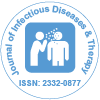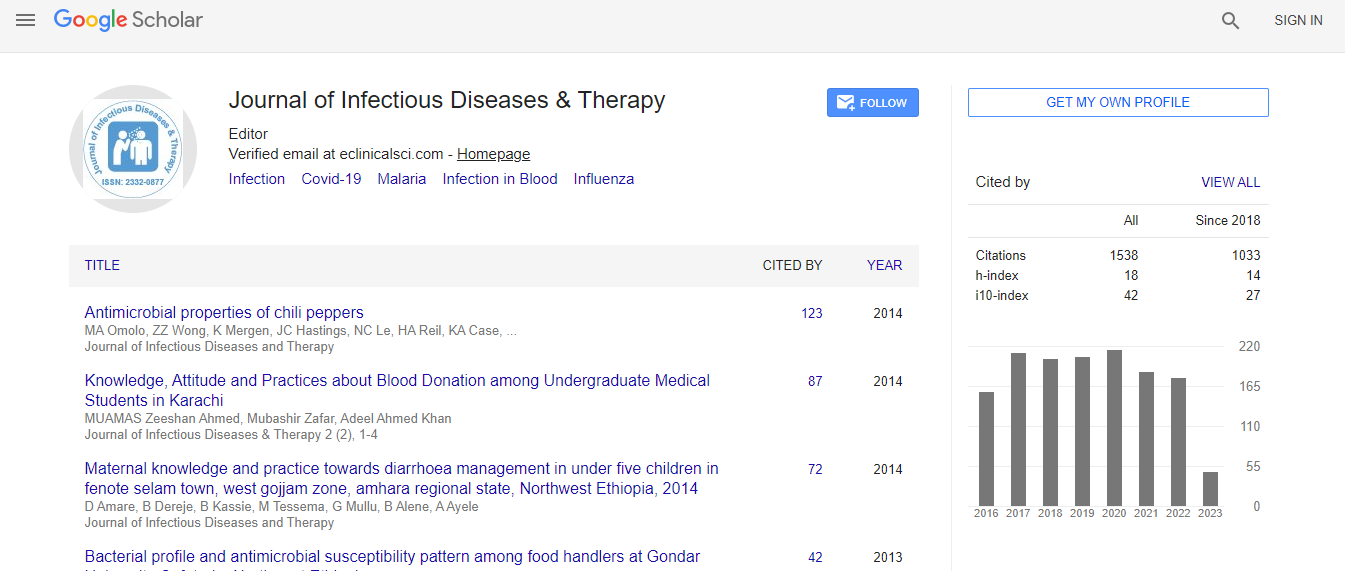Our Group organises 3000+ Global Conferenceseries Events every year across USA, Europe & Asia with support from 1000 more scientific Societies and Publishes 700+ Open Access Journals which contains over 50000 eminent personalities, reputed scientists as editorial board members.
Open Access Journals gaining more Readers and Citations
700 Journals and 15,000,000 Readers Each Journal is getting 25,000+ Readers
Google Scholar citation report
Citations : 1529
Journal of Infectious Diseases & Therapy received 1529 citations as per Google Scholar report
Indexed In
- Index Copernicus
- Google Scholar
- Open J Gate
- RefSeek
- Hamdard University
- EBSCO A-Z
- OCLC- WorldCat
- Publons
- Euro Pub
- ICMJE
Useful Links
Recommended Journals
Related Subjects
Share This Page
Prevalence and spatial distribution of soil transmitted helminthiasis and water, sanitation and hygiene resource in ogun state, nigeria
Joint Event on 4th Annual Congress on Infectious Diseases & 5th International Conference on Neglected Tropical & Infectious Diseases
Hammed Mogaji
Federal University, Nigeria
Posters & Accepted Abstracts: J Infect Dis Ther
Abstract
Soil-Transmitted Helminthiasis (STH) is one of the major public health problems in Nigeria. Efforts channeled towards complimenting preventive chemotherapy with a provision of water, sanitation, and hygiene (WASH) resources have been hampered by lack of empirical evidence on transmission hotspots to guide integrated control programme and resource distribution. A cross-sectional study involving 1,499 households across 33 communities was conducted in Ogun State in 2016-2017. Field visitations were made to recruited households for georeferencing and assessment of the condition of WASH resources using carefully WHO/UNICEF set standards. 1027(68.5%) of the sampled households provided fresh fecal samples for laboratory diagnosis of helminths ova using ether concentration. The WASH and STH data were compiled into a GIS database and subjected to the preliminary descriptive statistic. Spatial Maps were constructed using ArcGIS software. By demography, 600(40%) male and 899(60.0) female respondent participated in the study. Of the 20 LGAs examined, 19(95.0%) were endemic for one or more kind of the three main STH species (except Ijebu-Ode). Ascaris lumbricoides infections are the most geographically distributed species, found in 28/33(84.8%) locations and in 19LGAs. Hookworm was present in 19/33(57.6%) locations and in15LGAs. Trichuris trichiura infection was found in 9/33(27.3%) locations and in 7LGAs. An overall cumulative score of 52.9% was recorded for WASH resource conditions. The percentages score ranges between 65.7% and 38.6% across the LGAs. By categories, cumulative scores of 64.1%, 32.8%, 69.0% and 49.3% were recorded for water, sanitation, household hygiene and individual hygiene respectively. This study provides information on the prevalence and spatial risk of STH and WASH resources in Ogun State. This will serve as a decision-support visual tool for Ogun State programme managers to help facilitate the integration of STH control into WASH resource programming efforts.Biography
E-mail: mogajihammed@gmail.com

 Spanish
Spanish  Chinese
Chinese  Russian
Russian  German
German  French
French  Japanese
Japanese  Portuguese
Portuguese  Hindi
Hindi 